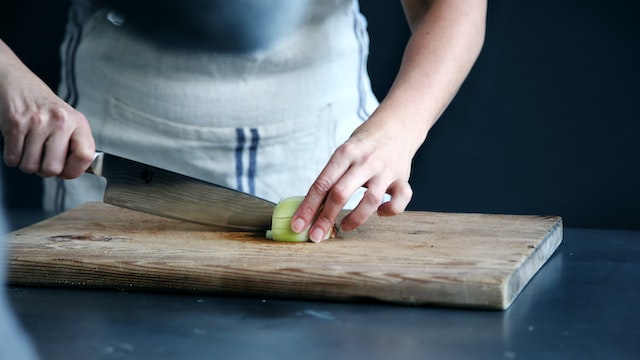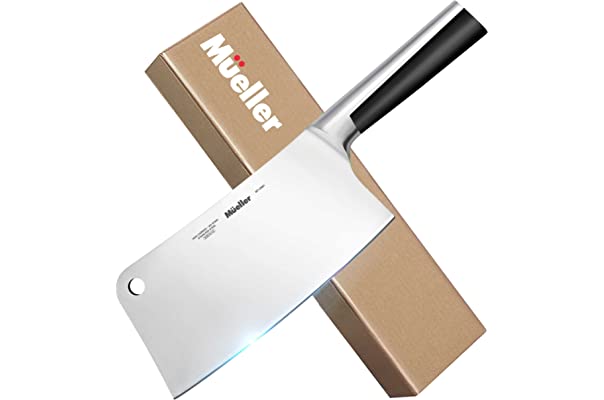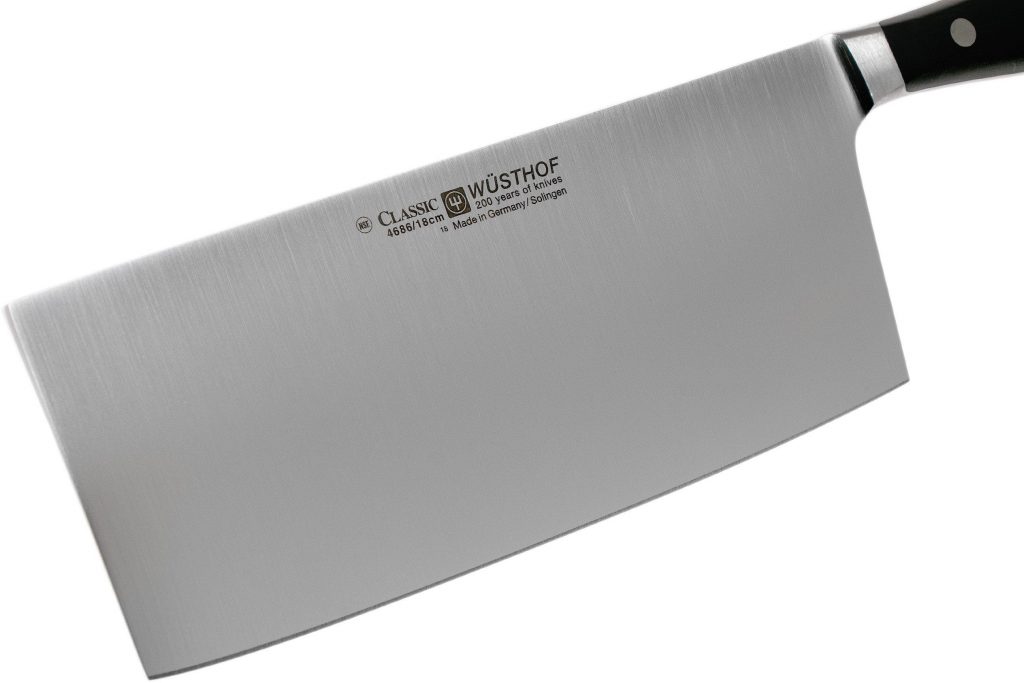Are you familiar with the Chinese chef’s knife? The brilliant construction of this knife means you can use it every day to effortlessly perform a wide variety of duties in the kitchen, like chopping, dicing, and mincing. Whether you’re preparing dinner for family or cooking up a feast for the whole neighborhood, this knife helps you chop faster and easier than ever before!
And in this article, I’ll help you choose the best type of Chinese chef’s knife and how to maintain it for longer shelf life. So keep reading this article, and don’t forget to comment on your kitchen experiences!
~WHAT’S SPECIAL ABOUT CHINESE CHEF’S KNIVES?~
Chinese chef’s knives are the go-to cutting tool in the kitchens of China. They’re used to cut, dice, mince, and chop just about anything, especially meat and vegetables. A Chinese chef’s knife has a straight edge that curves slightly up towards the tip. Its handle is usually made of wood, bamboo, or plastic. Some modern knives come with brightly colored handles or blade guards. The steel used in most Chinese chef’s knives tends to be softer than the steel used in Western knives. It does not have to be honed or sharpened as often either.

Keep reading this section to know more about the unique features of Chinese chef’s knives.
🟦 Description
As mentioned, a Chinese chef’s knife is a staple in every Chinese kitchen. A Chinese chef’s knife has a long blade (typically 8 to 14 inches) with a flat back. This makes it ideal for chopping. These knives are also thinner than other Western knives. And their blades are made from high carbon steel (the same material used to make Samurai swords). This means that they can be sharpened easily and will hold their edge for longer periods of time than other types of knives.
🟦 Pros and cons
The most obvious benefit of having a Chinese chef’s knife is that it makes cooking easier because you can chop more efficiently. But there are other advantages as well. You can slice through ingredients more quickly because this kind of knife has a thinner blade. This is great if you need slices that are paper thin! It’s also less likely than those other styles of the blade. Which will get stuck on bones when you’re slicing meat or poultry. Instead, they slide right through, so no bones remain on your plate!
On the downside, though, these knives aren’t appropriate for every job since there isn’t much variation between them aside from length. That means it may not be suitable if you need something extra heavy-duty like an ax instead! Also, these knives don’t have handles as some others do. Just one flat side where fingers could slip off easily unless careful attention is paid during use.
🟦 Purpose
The Chinese chef’s knife is the most versatile tool in your kitchen. It can be used for cutting, dicing, mincing, and chopping just about anything. But especially meat and vegetables. It’s especially handy for slicing chicken, beef, pork, and fish into bite-sized pieces. It’s also for dicing onions, garlic, ginger, and chilies and chopping up various herbs and spices (like cilantro or parsley).
🟦 Blade thickness
The Chinese chef’s knife has a thinner blade and a more flexible edge than a cleaver. This makes it better for slicing. Its blade is shorter than the cleaver’s, with a straight edge that curves slightly up toward the tip.
This knife can be made of carbon steel or stainless steel, depending on your budget and preference for maintenance. Carbon steel is durable but requires regular oiling. While stainless steel doesn’t rust but can become dull over time if not cared for properly.
🟦 Edge
A Chinese chef’s knife has a straight edge that curves slightly up towards the tip. It is not serrated, but it does have a slight curve to make rocking the blade easier for chopping vegetables and fruits. The blade is fairly thick, which makes it easy for you to get purchase it when cutting through foods that are hard or dense.
🟦 Handle
The handle is usually made of wood, bamboo, or plastic. The traditional choice is wood because it’s durable and comfortable to hold. A bamboo is also a good option for its strength and lightweight. Plastic handles are common in modern knives because they’re cheap to produce and can be molded into ergonomically shaped handles that fit comfortably in your hand. Some have finger rests to assist you when cutting with precision; some have holes for hanging on a hook when not in use; some even have lanyards attached to them so you can wear them around your neck like jewelry!
Some modern knives come with brightly colored handles or blade guards. The type of grip you prefer will rely on your personal preferences and how often you use the knife. Some people prefer to hold their chef’s knives by the blade, which can be dangerous if there is a bunch of wetness on the handle, as it can become slippery. Others may choose to use an oven mitt or towel to protect their hand when gripping the handle.
If you plan to buy one of these new types of knives, make sure that you know exactly what features it has before buying so that you don’t end up disappointed when it arrives at your doorstep!
🟦 Sharpness
The steel used in most Chinese chef’s knives tends to be softer than the steel used in Western knives. This means you can sharpen your blade with a simple wet stone, which makes it easier and cheaper to maintain.
A Chinese chef’s knife is typically not as sharp as a Western knife. In fact, the reason for this is that Chinese knives are made from softer steel than their Western counterparts. This means that they wear down more quickly and need to be sharpened more often (the reason why Western-style cooks often prefer Japanese or European-style knives).
~BEST TYPES OF CHINESE CHEF’S KNIVES~
Chinese cuisine is among the ancientest and most complex in the world. It has its own unique cooking techniques and equipment, which makes it quite different from Western cuisine. When you learn how to cook Chinese food properly, you’ll need to know about some special types of knives that aren’t used in other cuisines. These are known as chef’s knives or Chinese chef’s knives (sometimes called Chinese cleavers). The following are concise explications of each type:

🟦 Chinese cleaver
The cleaver is an extremely versatile knife that can be used for chopping, cutting, mincing, slicing, and dicing. It’s also used to cut meat and vegetables as well as fruit and herbs. The flat edge of the cleaver helps it to maintain its sharpness over time.
🟦 Chef’s knife
The chef’s knife is the most standard knife used in Chinese kitchens. It is mainly used to chop, slice, and cut meat, poultry, fish, and vegetables. The chef’s knives come with different blade lengths, from 6 inches to 14 inches. The longer the blade length is, the heavier it becomes, which makes you more tired when you are using it for a long time.
The shorter blades are lighter but do not have enough force to cut through bones or frozen food items like chicken breast or pork loin chops etc. So if you want a multipurpose knife, then go for 5-inch to 6-inch chef’s knives with sharp edges so that they can be used efficiently on vegetables as well as meat dishes without getting blunt easily after a few uses.
🟦 Slicing knife
A slicing knife is used for slicing meat and vegetables. The blade is long, but the handle isn’t as long as other chef’s knives. This allows you to cut down onto a cutting board without hurting yourself. Slicing knives are also great for fish and meat because they have such a sharp tip that they can penetrate through the skin with ease.
It’s important to note that there are two types of slicing knives: single-beveled and double-beveled (or hollow). For this reason, when purchasing one, it’s important that you know which type you need and which one will function best with your style of cooking.
🟦 Sashimi knife
Sashimi knives, also known as sushi or fish fillet knives, are thin, light, and small in size. They are used for slicing raw fish. Sashimi knives have a shorter blade than the average chef’s knife, which makes them perfect for cutting through the slimy skin of fish and producing clean cuts with minimal effort. So if you want to cut up some sashimi, then invest in a good quality sashimi knife!
🟦 Santoku knife
Santoku knives are Japanese in origin, and they’re intended for slicing and dicing vegetables. The word Santoku (the name means “three virtues”) refers to the fact that these knives can be used for chopping, mincing, and slicing. They’re similar to chef’s knives but usually smaller. Some santokus are only eight or nine inches long, while others are as long as 12 inches. Santoku knives often have a triangular-shaped blade with a straight edge that tapers slightly toward the tip of the knife, so it’s easier to control when you slice through food.
Santokus come in several different styles. You can choose between those with flat blades or curved blades. Curved blades allow for more rocking motion when cutting. Another significant element is whether or not your santoku has a bolster. This is a metal piece between where your thumb rests on top of the handle. A bolster is important because this adds balance and strength to your knife overall. As well as making it easier to hold onto if you’re using it over heat sources like stoves or grills
🟦 Chinese meat cleaver
The Chinese meat cleaver is a very heavy knife that is used to chop meat and bones. It can also be utilized to score through the bones of fish. The Chinese chef’s knife will make short work of these tasks, but if you want something with more heft, then this is the blade for you!
~CHINESE CHEF’S KNIFE FOR DAILY USE~
The Chinese chef’s Knife is used to chop, slice and dice. It comes in a wide variety of sizes, but this one is the best for chopping vegetables and other foodstuffs. The handle is well balanced and comfortable even when you use it for long periods of time. But for daily use, here are the features of Chinese chef’s knives you need to look for.

🟦 Ceramic blade with impregnation
Ceramic blades are not as hard as steel, so they are not as sharp. However, their hardness is superior to that of carbon steel knives, meaning that ceramic knives can be resharpened with water stones or diamond stones. They also have elevated resistance to deterioration and rust better than other materials such as stainless steel and carbon steel (which is why they’re used in marine environments).
Ceramic blade knives do not need to be oiled like the traditional Japanese sushi knife because they don’t easily rust or tarnish. They don’t bend like stainless-steel blades either, which makes them perfect for everyday use, such as chopping vegetables or slicing meat at home or work!
🟦 Big and heavy handle
When you’re cutting something large, it can be difficult to maneuver a knife with a lightweight handle. The heavier handle will help you control the knife better. This is why this type of blade is ideal for slicing and cutting meat or fish. However, if you have to chop a lot of vegetables, then a lighter blade would be more convenient. Likewise, if you’re just cooking for yourself at home and not going to do any big cooking jobs where heavy blades are needed, then this type of knife isn’t necessary either!
Suppose your hands get tired easily when holding onto heavy objects for long periods of time (like chopping vegetables). In that case, using this kind of blade might make things even worse because these types tend to be quite chunky and don’t necessarily fit into one hand comfortably either – so keep this in mind before buying one yourself!
🟦 Decorative bolster
The bolster is a flat piece of metal or plastic that’s placed between the blade and handle. It serves two purposes: it protects your hand from slipping when chopping, and it helps to balance the knife as you use it.
If you’re choosing a bolster, there are two main types to consider: plastic and metal. Plastic is more commonly used in cheaper knives, while more advanced (and expensive) models will have bolsters made of stainless steel or copper alloy. Metal bolsters tend to be heavier than their plastic counterparts, but they’ll give you greater control over your knife’s movements while also providing extra durability during everyday use.
~PROPER MAINTENANCE FOR CHINESE CHEF’S KNIVES~
If you’re anything like us, the idea of taking care of knives might sound intimidating. We want to use our knives, and we want them to be sharp, but how do we keep them that way? That’s why we’ve put together this resource, which will help you learn how to properly maintain your Chinese chef’s knife so that you can use it every day. And never have to think about sharpening again!

🟦 Before use
Before you use your Chinese Chef’s knife, you should clean off any corrosion with coarse salt and oil. This will terminate any grime or debris that may have accumulated on the blade during storage. Here’s how to do it.
- First, use a dry paper towel to remove any dirt or debris from the blade of the knife (this is optional).
- Next, take a small amount of coarse salt and rub it over the entire surface of your knife in order to remove any corrosion. This should only take about one minute for each side of your steel chef’s knife.
- Finally, wipe off all excess salt with another paper towel before using an untreated cloth to apply oil to both sides of your blade as well as its spine (the metal part where you hold it).
🟦 After use
After each use, wash your blade with hot water and a sponge. Do not let the knife drench in the sink or use abrasive materials to clean it. It may be tempting to let the knives air dry, but resist! The moisture from air drying could make your knives rust. Instead, use a silky towel or fabric to dry them thoroughly before putting them away. Never put knives in a dishwasher because they’re too delicate for this type of cleaning process.
🟦 Storage
Wooden blocks and magnetic strips are the best way to store knives, as other surfaces may dull the blade. These are typically more expensive than magnetic strips and can only be used for certain knives. Whereas magnetic strips can be used for any type of knife. Magnetic strips are also more convenient than wooden blocks because they’re able to stick onto your refrigerator door or another metallic surface.
🟦 Banging
When storing your knife, try not to bang it against other kitchenware. This can dull the blade and lead to a loss of control over the tool. If you want to hang your knives, I recommend using a magnetic strip. These are affordable, easy to put and provide plenty of space for multiple knives and other utensils.
🟦 Submerging
You must also be careful not to submerge the blade of your knife in water for a prolonged period of time. If you do this, then the blade will rust, and you will have to clean it immediately. Rust is a state of corrosion that can cause permanent damage to your knife (and any other metal object).
If you want to get rid of rust on your knives, we recommend using vinegar or lemon juice—they’re both natural acids that work well at removing rust from metal surfaces. You can also rub a smallish amount of vegetable oil onto the affected area with a rag or paper towel before washing it off thoroughly with warm water and soap.
🟦 Honing
To keep your knife sharp, you should hone it regularly. If you have a whetstone, it’s as simple as that. You simply need to keep the angle consistent between each stroke and be sure not to press too hard, or else you will take off too much metal.
If you don’t have a whetstone, there are alternatives available in the form of electric sharpeners that can get your knives razor-sharp in seconds (but they cost quite a bit). You can also use a sharpening steel. Although this method is slower than using an electric sharpener because it just involves rubbing the blade across one side of the steel at an angle until it gets honed enough for cooking purposes (if done correctly).
Please note: Do not use your chef’s knife for tasks other than slicing food. Otherwise, it will quickly lose its edge and become dangerous instead!
~BOTTOM LINE~
If you have ever used a Chinese chef’s knife, whether, in a restaurant or kitchen, you know how well it works for its job. While owning a vast assortment of knives is not always necessary, a good quality knife is essential for anybody who does any sort of cutting or slicing. And Chinese chef’s knives will be able to handle almost anything you need them to do.
If you are looking for steak knives, click here!
